Test
Ireland & Britain
England & Scotland
Travel Stories
Interests & Hobbies
Outdoors & Activities
Advice for Visitors
About My Ireland Tour
News & What's On

The coastline of the South West is a meandering mix of inlets, coves and peninsulas, so there is plenty of opportunity for cliff-top walks and rambles. Inland, the landscape is scarcely less rugged: throughout the region, farmland is interspersed with rocky outcrops and bogs which break up the luscious green vistas. The South West is also home to two of Ireland's top tourist towns: with good reason, Killarney and Cork are firm fixtures on the to-do lists of most first-time visitors to Ireland.
In recent years, the towns and their people have become the main attractions of the southwest. Boasting the likes of Kinsale, Clonakilty, Kenmare, Killarney, and Dingle, to name but a few, the Counties of Cork and Kerry have become synonymous friendly, welcoming atmospheres, vibrant nightlife, and stunning scenery.
The region is also home to world-famous attractions such as the Blarney Castle, the English Market, the Ring of Kerry and the Jameson Distillery. Below we have drawn up a list of the essential visits during your time in the southwest.
Cork is the second-largest city in the Republic, but the locals call it "the real capital of Ireland". They might not be the most impartial judges, but many visitors are inclined to agree, leaving this compact and alluring destination with an enduring fondness and a full belly: Cork is known throughout Ireland for its exceptional food. While it is compact, Cork City has essentially two main streets, and you could walk from one end of the city to the other in about 10 minutes—it's packed full of hidden gems. If it's possible, find a Cork local for a tour of the city. The places that are off the beaten track, and rarely mentioned on Travel Guides, are the most memorable. Head down the side-streets, some that lead onto others, some that are dead-ends, and it's likely that you'll come across a unique place to have a drink or something to eat.

If you're sampling any of Cork's many pubs, be sure to try a pint of Beamish – Cork's answer to Dublin's more famous Guinness. The transition from the city to the suburbs is pretty blunt in comparison to other European cities, walk out of Cork City, in any direction, and within 10 minutes you'll be surrounded by leafy roads, ponds, woodlands and the general great outdoors. The city has been reinventing itself with outdoor dining, pedestrianized street and covered markets with food stalls.
If you're looking for the best way to see the Rebel on foot, check out our Cork City Walking Tour page.
Perhaps the best way to experience this charming and friendly seaport is on foot, though be aware that it is a little hilly! A signposted walking tour will guide you past St. Finn Barre's Cathedral and the riverside quadrangle of University College to the panoramic viewing point of Shandon Church tower.
Situated five miles north-west of Cork city, Blarney Castle is a solid fixture on almost any tour of Ireland itinerary. It is best known for the famous "Blarney Stone" which visitors are encouraged to kiss, in accordance with a tradition that spans the centuries. Those who kiss the Blarney Stone are said to magically receive the "gift of the gab", — or as we call it in Ireland... a load of old Blarney.
Built over 600 years ago by Cormac MacCarthy, one of Ireland's greatest chieftains, Blarney Castle has attracted millions of visitors who continue to flock here hoping to be gifted with the power of persuasive and elegant speech. Visitors can now explore the castle's stunning gardens and interior, including the winding staircase and dungeons.
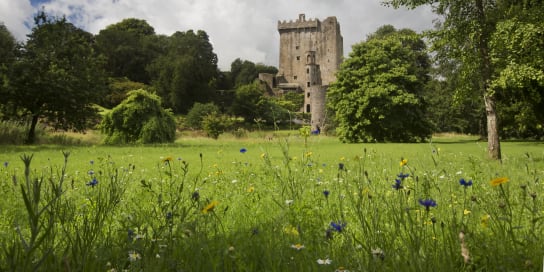
During the mid-17th century Irish Confederate Wars, the castle was besieged by British forces led by Oliver Cromwell's commander, Lord Broghill. It was eventually captured after heavy bombardment, resulting in its partial destruction.
While not the largest or most imposing of Irish castles, Blarney Castle has a certain charm and elegance that's hard to forget. You can also look inside the adjacent Blarney House, a stately mansion built during the 18th century and the nearby Blarney Woollen Mills, an Irish heritage shop famous for its wool garments and a fantastic café!
The spiral steps to the famous Blarney Stone can feel very narrow at peak times. Those with limited mobility should proceed slowly and carefully, however many people may be waiting behind.
Buy your tickets online to get an online discount.
You will find Blarney Castle 8 km from Cork City in Blarney Village. We recommend spending 3 hours exploring the castle and garden as well as the caves, lake walk, fern garden and arboretum. Maps are available at the ticket office in several languages. Audio guides in English are also available.
The opening hours for Blarney Castle and Gardens every day in May through September are 9am to 6pm. Opening hours are shortened from January to May. The opening hours can change according to weather conditions. Find out more about the opening hours.
A ticket for Blarney Castle costs €22 for adults, and €10 for children aged between 6 and 16. Students' and seniors' tickets cost €17.
If you look up the word 'quaint' in a dictionary, don't be surprised to find a little picture of Dingle, a fishing port full of charm and allure. Expect its narrow streets to be bustling with visitors during high season. When you're ready to take time out, stop off at one of the many small Irish pubs and enjoy a pint of Guinness with the locals.

This picture is from Dingle Whiskey Distillery which is well worth a visit if you're partial to a tipple. You could easily fill a day with a distillery tour of Dingle, in recent years there has been a surge in the number of distilleries and breweries setting up in the town and the surrounding areas. Dingle is also known for its vibrant yet relaxed night-life, especially during the summer months. Hotels and B&B's in the area, from April to September, can fill quickly, so, it is well worth booking your accommodation well in advance.
Self-drive tourists should keep in mind that the roads leading to Dingle are quite twisty and narrow, and you will likely come across some tour buses en route. Turn off the radio, tell the kids to pipe down and enjoy a slow, safe journey to a destination that is well worth the trip.
Take one of many the boat tours along Dingle Bay
Even since production moved to a modern facility nearby, the world-famous Old Midleton Distillery continues to draw huge numbers of visitors who are as curious about The Jameson Experience as ever before. Over 130,000 tourists visit Midleton every year to learn more about the home of Irish whiskey.

The charm and elegance of the original distillery buildings reflect the pride in the product that was made here. Expect an engaging insight into the culture and history of Ireland, told through one of the nation's most famous exports.
At the beginning of the tour, there is a very informative audio-visual presentation detailing the whiskey-making process used by Jameson throughout the ages. You are then taken to the old distillery dotted along the trail there are antique vehicles, water mills, barrels and casks which really add to the sense of heritage.
The final leg of the tour is the pay-off... a glass of Jameson! There is the option to have this straight up or with Ginger & Lime. If you are quick enough to volunteer there is a comparative tasting of an Irish whiskey, a Scottish whiskey and an American bourbon with an explanation on the differences and making of each.
Road signs to the Distillery are not as obvious or as plentiful as you might expect. Drivers should plan their directions before they set off.
You can take a tour between 10:00 and 16:00. The gift shop and bar start selling alcohol after 10:30 on Monday to Saturday and 12:30 on Sundays.
An adult ticket will cost 23 euro and a child (under 18) ticket 11 euro.
Ireland's longest circular route covers some staggeringly beautiful scenery, including lakes, beaches, glens, castle ruins, off-shore islands, mountains and, of course, the Atlantic Ocean to the west. A journey around the Ring of Kerry is a must for any first-time visitor to Ireland.

In a car or bus, the Ring of Kerry's 180 km can provide distractions enough to fill a day, but there is no shortage of places to stay overnight and, depending on your interests, you can certainly find plenty of interesting diversions to make it a trip of two or more days. If it's your first time driving country roads in Ireland, the Ring of Kerry would not be an advisable place to start. Even the most seasoned of Irish drivers can struggle here. Sometimes the road will be so narrow as to barely fit one car, add the endless amount of tour buses passing up and down the road and you'll have a front row seat for some very skilled manoeuvring.
The Skellig Ring, a shorter and less travelled route, is an extension of the Ring of Kerry. This hidden gem is just as quaint as the famous Ring, but without the tour buses. If you can't get enough of the peninsula, you can explore the heartland as well with it's windy roads that cut through the hills.
The route can also be cycled or even walked. Look out for the 230km "Kerry Way", Ireland's longest way-marked trail, which passes through towns such as Glenbeigh, Caherciveen, Waterville, Sneem and Kenmare. During the peak season, the Ring of Kerry (or Iveragh Peninsula) can be quite slow-moving, especially heading in the anti-clockwise direction favoured by tour buses. So sit back, relax and enjoy the mesmerising views.
The definitive Irish tourist town, Killarney has something for everyone and, after Dublin, is generally the first place name to be added to the itinerary of any Ireland tour. The town has been welcoming visitors for over 250 years. As the perfect base to explore Kerry and the National Park, Killarney can get quite busy during the summer months.
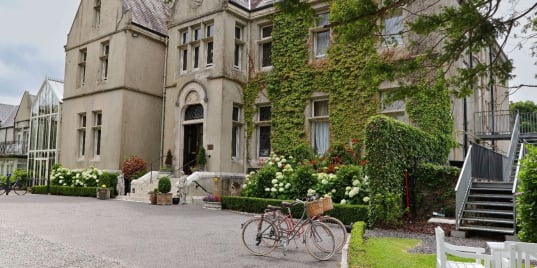
Though perhaps offering fewer historical and cultural attractions than its east-coast counterparts, Killarney more than makes up for this with the welcoming bustle of the town itself and the staggering natural beauty of its neighbouring namesake, the national park just five-minutes' drive away.
The town of Killarney will provide ample diversion for those looking to go shopping and those looking for a Guinness and some traditional music. For the many who choose to do both, there is no shortage of good restaurants to segue your daytime and night time activities in the town.
Those who are seeking a little culture during their time in the South West should head to the heart of the Killarney National Park, where they will find the region's most impressive stately home, Muckross House. Just one mile away, you will also find Muckross Abbey, a beautiful construction which - after two hundred years of service - was burned to ruins by Cromwell's troops in 1652.
Muckross Estate, the focal point of the Killarney National Park, was donated to the Irish Free State in 1932. Its grounds became Ireland's first national park and. Over time, it has expanded to encompass nearly 25,500 acres of lakes, mountains and native oakwoods and yew woods. This includes the highest mountain range in Ireland, called MacGillycuddy's Reeks.
The jewel in the crown of the park is its majestic lakes, Lough Leane (the lower lake), Muckross Lake (the middle lake), and the Upper Lake. These lakes make up a quarter of the park's area and continue to draw admirers in huge numbers ever since the park first opened. Hidden behind Dinis Cottage you can find the place, called Meeting of the Waters, where these three lakes meet.

Killarney National Parks & Lakes are located a short distance from the town of Kenmare on the Wild Atlantic Way.
Weather permitting, one of the best ways to see a large portion the park in one day is by hiring bikes. There are numerous bike hire shops in Killarney town.
As a city, Cork retains a great deal of its historical and archaeological heritage. There is no finer example of this than Cork City Gaol, a towering edifice situated just 2km north-west of Patrick's Street. Opened in 1824, the gaol was heralded as "the finest in three kingdoms", though inmates at the time might not have agreed.
Located in the Sunday's Well area of Cork, Cork City Gaol is currently a museum and visitor attraction. Visitors can step back in time and witness what life would have been like for both prisoners and guards of Ireland's most famous gaol. Opened in 1824 to replace the old Gaol of Northgate Bridge it soon became seen as a marvel of architecture and a feat in logistics for its time.

In its heyday of the 19th and early 20th Centauries, Cork City Gaol was home to some of Ireland's most notorious prisoners. During the early 1800s, the gaol's walls housed many temporary prisoners before they were taken to convict ships bound for Australia. Later in the same century, the gaol's guests included Young Irelanders Derry Lane, Terence Bellew McManus, Ralph and Isaac Varian. In the 20th century, its most famous prisoners included Fenians James Mountaine and Brian Dillion and revolutionary nationalist Countess Markievicz.
Today the gaol has been redesigned as a visitor centre, refurbishing the cells as they would have been hundreds of years ago. Original scrawlings on the walls of the cells added with eerily realistic wax figures of both guards and prisoners give the whole experience a very voyeuristic feel.
Unlike their predecessors, visitors today have the freedom to roam the gaol's catacombs for the price of €8 (concessions available). The tour takes visitors back in time, recreating the harsh realities of nineteenth century incarceration while exploring some of the underlying causes of contemporaneous crime.
The self-guided tour of the gaol is available in 13 different languages. Cork City Gaol has a souvenir shop, tourist information, picnic area and a café.
Be warned that this is an old stone building and prisoners here did not enjoy the benefits of central heating. Wrap up warm if you tend to feel the cold.
The self-guided tour of the gaol is available in 13 different languages. Cork City Gaol has a souvenir shop, tourist information, picnic area and a cafe.
The most up-to-date opening hours can be found here:.
Unlike their predecessors, visitors today have the freedom to roam the gaol's catacombs for the price of €10 (concessions available). The tour takes visitors back in time, recreating the harsh realities of nineteenth century incarceration while exploring some of the underlying causes of contemporaneous crime. Audio guides are available for €2 extra.
Bring your Euro and a sense of curiosity as you explore the small, Bohemian shops, great restaurants and pubs, which line the narrow streets. A favourite destination for international and Irish visitors, Kinsale is hugely popular on our own Ireland tour vacations.

Travel magazine, Condé Nast, recently hailed Kinsale as one of Ireland's Most Beautiful Villages. Kinsale, located only 25km from Cork City is also the start/finish point of the Wild Atlantic Way and has been named 'The Gourmet Capital of Ireland'.
The tourist information offers maps of the narrow shopping streets which surround it in Kinsale centre. This is the starting point for most of the local walking tours. There is a beautiful coastal walk leading to Charles Fort.
Take one of the guided walking tours leaving in front of the tourist office, if you want to learn more about the rich history of Kinsale.
Built in 1845 the Cork Public Museum known then as The Shrubberies is located on the grounds of Fitzgerald Park. It was originally built by the Beamish family and was for years their family home. Cork Corporation eventually purchased the house and its surrounding land and used it as a showcase for the Cork International Exhibition of 1902 and 1903.

The museum officially opened in 1910 but after the burning of Cork City in 1920 it was used as the city's Municipal Offices. After being used as an Air Raid Protection office during World War II the museum finally opened in 1945.
Today, the Museum gives an expansive history of Cork and covers a wide selection of topics. Everything from barrel-top caravans to costumes of the 18th century, from Ireland's oldest shovel to a selection of Cork Silver can be found within the museum exhibitions.
The Riverside Café has recently opened within the Museum and gives visitors the perfect opportunity to enjoy the marvellous views. Cork Public Museum really has something for all ages and, if the weather holds up, a walk around the magnificent Fitzgerald Park is a must. Entry to the museum is free and you can find out more about the opening hours here.
A good museum for those with children. It's quite small and interactive. If they get bored or restless, the park outside is a great place for them to let off steam.
Opened to the public in 1906 and has since become a bustling attraction for both visitors to Cork City and locals alike. The magnificent gardens of the houses of Sunday's Well can be seen from one side of the Museum while the roadside view is flanked by buildings owned by University College Cork.
The Franciscan Well Brewery was founded in 1998 by Shane Long. It was built on the site of an old Franciscan Monastery. It is said that the well within this monastery had was given to curing the ailments of those who drank from it. People would come from across Ireland to make use of its miraculous powers.
Brewers, operating from the well today, still harness their unique output while adding modern technology and techniques learned from across Europe. It is currently Ireland Number 1 Craft Brewery. The Franciscan Well has collaborated with fellow Cork drink makers Jameson Whiskey to create a truly Corkonian beverage a Jameson-Aged Stout.

The brewery is where new drink ideas are formed and if they pass the brewers standards they are then served up at the Brew Pub in Cork City. If they are successful here then they will be exported further afield.
The Brew Pub, located within the original brewery on Cork City's North Mall, is currently one of the city's hot spots. It's a modern pub with a historical twist. The original brewing vat sits in the middle of the beer garden, alongside a huge pizza oven. The latest creations from the brewery are tested by the clientele and, if the weather holds out, entire evenings can be spent arguing about the best pizza and beer combination.
The inside of the pub, built on the burial ground of the old monastery, is also a fantastic spot to sample some of Cork's finest delights ...as long as you don't mind the occasional ghost.
Arrive hungry and try the freshly baked pizza which is available in the beer garden out back. Delicious, salty dough that makes you want to linger for just one more trip to the bar!
We couldn't resist visiting this amazing brewery ourselves to sample the legendary beers and pizza. Click here to find out how our visit went.
Ideal for a lunchtime stop more than a full-day excursion, Kenmare and Sneem both give a great insight into the relaxed pace of life which characterises this part of Ireland. Pull up a chair and take your time over a nice coffee ... or maybe a Guinness. A farmers market with local produce is held every Tuesday from June to September in Sneem.

The more spiritually-minded might enjoy a detour to Kenmare Stone Circle. But some visitors find the €2 entrance fee to be an all-too-earthly welcome to such a mystical spot.
A living-history museum, Kerry Bog Village offers a heritage-award-winning insight into the harsh realities of life for the rural poor in famine-ravaged 18th-century Ireland. Thatched cottages within the village are decorated and furnished to represent, with well-researched exactitude, the real-life experiences of those who lived their lives in this part of Ireland during the nation's harshest times. A valuable and rewarding trip if you want to understand this chapter of Ireland's history.

Stop for an Irish coffee to warm the cockles!
Situated on the N70, half way between Glenbeigh and Killorgin. Next to the Bog village you will find the Red Fox Inn Bar and Restaurant where you can buy a ticket if nobody is at the Gate to the Bog Village. Comprehensive booklets are available in different languages at the museum entrance.
Open 7 days a week from 09:00 to 18:00.
Adult will pay 6.50 euro and children 4.50 euro to enter the village and explore the 18th century way of life.
Skellig Michael, also known as Great Skellig, is a rocky outcrop island located 11.6 km to the west of the Iveragh Peninsula in Country Kerry. Sceilig Bheag (Little Skellig), its twin island is small and completely inaccessible. Skellig Michael is a world heritage site and was used as a monastic settlement by monks in the 7th century. Hollywood came calling to the island in 2014 when Episode VII of the Star Wars franchise chose it as a location for its final scene. The location was chosen for its otherworldly appearance thanks to its unique combination of Old Red Sandstone and compressed slate.
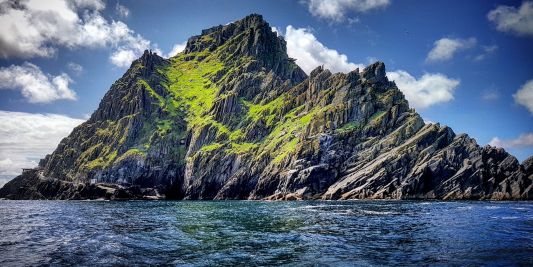
To visit Skellig Michael you will have to book a landing tour with one of the boat operators. We advise to book your tour well in advance as only 180 people are allowed to access the island each day. The landing tours are subject to weather conditions and can be cancelled if they are bad. The boat trip normally takes around an hour and the visit to Skellig Michael approximately 2,5 hours. Most boat tours leave from Portmagee pier and are available from May to the beginning of October.
Visitors to Skellig Michael should be prepared for what is a very tough ascent to the summit. The stone steps can be dangerous when wet and there are no handrails. This ascent is only advisable for people free of any mobility issues.
Elizabeth Fort was built in 1601 by Sir George Carewan and was named after Queen Elizabeth I. It is located outside the medieval walls of Cork City, Originally built on wood, stone and mud it is torn down within two years by the people of Cork after the death of Queen Elizabeth. English reinforcements are brought in and seize control. The people of Cork are forced to pay for the forts reconstruction

In 1626 the fort is rebuilt in stone. The design takes on the present-day star shape and the majority of the fort from this rebuild survives today. Oliver Cromwell orders the fort walls the be heightened in 1650.
During the 18th century, the fort is used as an army barracks. Including the barracks in the nearby Barrack Street, there are 750 soldiers housed here. In the early 19th century the fort is used as a prison for convicts waiting on transportation to Australia. In 1929 the Fort became a Garda station and was in use as such up until 2013.
Today the Fort is a free visitor attraction and a fascinating step back into history. There are different aspects of each of the stages of the fort's history including statues of soldiers, cannons and model radio control rooms. Probably the most spectacular part of the tour today is the view that visitors receive of Cork City and the nearby St.Finbarr's Cathedral.
Parts of the fort, the car park and the restrooms are all wheelchair accessible, making this one of the city's more appealing historic buildings for those with lower mobility.
General admission is free of charge and the fort is open from Monday to Saturday from 10:00 to 17:00. The opening hours on Sunday are 12:00 to 17:00. A guided tour starts at 13:00 every day and costs 3 euro.
The English Market is a food market that connects Princes Steet and The Grand Parade in Cork City. It has been in its present location, in one form or another, since 1788. The English Market is closed on Sundays, but open on all the other weekdays.

The name 'The English Market' was thought up in the 19th Century to differentiate it from The Irish Market (currently the Bodega on Cornmarket Street). From 1788 until 1980 the interior of the market changed very little. A fire on 19 June 1980 saw the Cork City Council undertake an extensive refurbishment of the property.
Today the market is a focal point for Cork's shoppers. The diversity of its products, friendliness of its traders and its overall aesthetic beauty ensure both locals and visitors to the Cork City flock to its stall on a daily basis. Queen Elizabeth II, on her 2011 Tour of Ireland, made sure to drop by The English Market to take a look around.
Breaks from shopping can also be enjoyed in the market's cafés. The ready to eat hot dogs, from one of the many butchers, are also an unmissable treat. So if you are in Cork and are looking for the best quality food, exotics produce or simply going for a stroll, a visit to The English Market is essential.
One amazing treat that we came across was in The English Market was The Chocolate Shop. A delightful one-stop shop for the finest chocolates found throughout Europe. They are completely independent and are not tied down to any particular manufacturer. They only stock chocolate that passes their standard... and wow, it's quite a standard. A must for any chocolate lover in Cork City.
If you're staying in self-catered accommodation in Cork, then the Market is a must. Lots of the produce available here is fresh meat and fish. A dream for any visiting foodie. There are also lots of ready-to-eat delights available to enjoy while you wander around.
Spike Island, lying off the coast of County Cork, is a 104-acre island. It is a five-minute ferry ride from the town of Cobh. Over the past 1,300 years, Spike Island has been home to a monastery, a fortress and, most recently, a prison. Fort Mitchel, built in the 18th century by the British Army to defend against enemy forces, dominates the landscape of the island. It is a 24-acre star-shaped Fortress that was used as a base by both the British and Irish armies.
Later, Fort Mitchel became a prison that could house up to 2,300 prisoners, both men and women, many of whom were later sent to finish their sentences in the USA or Australia. The fort was completed in 1850, and at the time was at the cutting edge of military technology. Today, it houses Ireland's largest military gun park. Fort Mitchel became a full-scale prison in 1847, in the middle of the Great Irish Famine. It had also been used as a place to hold prisoners, during Cromwell's time, but the rise in crime caused by the desperation of the Irish people during the Famine created the need for it to become a fully-fledged prison.
During the War of Independence (from 1919 to 1921), the prison held members of the Irish Volunteers. The most famous escape from the prison came during this time when Seán MacSwiney, Tom Malone and Con Twomey fled the island and were picked up in a boat by members of the IRA. In September 1985, the prison was the scene of a riot by prisoners, who eventually took over the island. Hours later, Gardaí arrived and seized back control. The island remained a prison and a military base under Irish rule until its eventual closure in 2004.

Today, Spike Island is one of Ireland's top tourist destinations. In fact, it was named the top tourist destination in Europe for 2017 at the World Travel Awards, beating off competition from the likes of the Eiffel Tower, the Colosseum and Buckingham Palace. Part of the reason for the success is the Spike Island tour guides. Full of enthusiasm, with genuine knowledge of all aspects of the island, you can't help but get lost in their stories and insight.
The sense of history you feel, as you walk through the prison's eerie corridors and into its cramped cells, is in equal measures overwhelming and exhilarating. Slash hooks and make-shift knives, used by prisoners during the riot of 1985, are on display, along with other utensils crafted by the prisoners during their day-to-day lives. The military side of things is well catered for too, with displays including uniforms, guns and countless documents. Perhaps the most impressive part of the tour is the military gun park. Featuring over a dozen exhibits, ranging from tanks to anti-aircraft artillery, it is the largest of its kind in Ireland and is a firm favourite with both military enthusiasts and children alike.
As the majority of the tour takes place outdoors, be sure to dress for the possibility of rain.
For those seeking out the eerier side of things, there's After Dark tours available, where you are taken through the prison corridors by candlelight.
As parking in Cobh can be relatively expensive, your best bet is to catch a train from Cork City and back. These run around every half hour and cost around €10 return.
An adult ticket to Spike Island costs 22 euro and includes the crossing on the ferry. Your return ferry is 3.5 hours later. A guided 45 minute tour is also included in your ticket. For more information and times follow this link.
Built in 1722 and overlooking North Gate Bridge, Shandon Tower is one of the most famous members of Cork City's skyline. Originally the site housed St. Mary's Church before it relocated to Shandon Street in 1693. At the start of the 18th century, the area around Shandon became the hub of the world's butter trade.

The famous Red and White sporting colours of the Cork teams in both Gaelic Football and Hurling are said to have their origins within the walls of Shandon Tower. The North and East walls are made of red sandstone while the South and West walls are made of white ashlar limestone.
The eight bells of The Shandon Tower are accessible through steep steps that take you up past the clockwork operating the four sized clockfaces. These clock faces became known locally as 'the four-faced liar' due to the four clocks seemingly never showing the same time. The salmon shaped weather vane known as 'the goldie fish' is four meters long and covered in gold leaf.
Caulfield Orpen designed the World War One memorial and is said to be one of the finest of its kind. There are five stunning stained-glass windows including St. Luke's window by Hubert McGoldrick. After climbing the 132 steps the views on Cork City are nothing short of breathtaking. Ringing the bells that are heard across the city of Cork is a once-in-a-lifetime experience.
A bucket-list experience for anyone who wants to ring church bells, but a less attractive prospect for anyone with mobility issues. You should arrive expecting lots of narrow steps.
Please Note that access to the tower depends on weather conditions and religious services in the church. Check their social media posts before your visit.
Open in June to September from 10:00 to 16:30, Monday to Saturday and from 11:30 to 16:00 on Sunday.
Open in March to April and October from 10:00 to 16:00, Monday to Saturday and from 11:30 to 16:00 on Sunday.
Open in November to February from 11:00 to 15:00, Monday to Saturday and from 11:30 to 15:00 on Sunday.
Adults will pay 4 euro and a ticket for children (aged 5 to 15), is 2 euro.
The Beara Peninsula runs along Ireland's southwest coast, between Kenmare Bay in County Kerry and Bantry Bay in County Cork. There is evidence of human settlements in the Beara Peninsula dating back to 3,000 B.C. In the 17th century, the area was used by the British army against the French invasion. There are currently 6,000 people living here. Before the Great Famine of the 1840s, there were almost 40,000. It is home to two mountain ranges, Slieve Miskish Mountains & Caha Mountains, and is part of the Wild Atlantic Way.

To get the most out of this beautiful and expansive landscape, a car will almost certainly be needed. Hire a car in Cork or seek out a local tour guide to show you the best local spots.
On hearing about the rejuvenating tranquility of this magical place, we couldn't resist a visit of our own. Find out more about our journey to the Beara Peninsula
Located 5 miles from the County Kerry town of Killarney, Torc Waterfall is one of the town's more spectacular tourist attractions. The surrounding woodland is heavily populated with red deer. A public hike leads from the waterfall to the top of Torc Mountain. The waterfall is one of the highlights of the 120-mile Kerry Walking tour.

If you would like a slightly longer hike there is a loop trail that takes you up and around the falls for a beautiful view of the lake and then down into the meadow where you might even see wild deer.
There is a car park on the N71, located 300 meters from the waterfall. However it is tiny, so it can be hard to find a spot. There is another car park a bit further down the road. Please note that you will have to walk down a busy road if you park there.
Muckross House is located between two of the Lakes of Killarney, Muckross Lake and Lough Leane. It was designed by Scottish architect William Burn and was completed in 1843. The first occupants of Muckross House were Henry Arthur Herbert and his wife Mary Balfour. In total, the Tudor style house has 65 rooms. After paying for renovations to the house, in anticipation of Queen Victoria's visit in 1861, the Herbert family fell into financial difficulty. They sold the estate in 1899 to Arthur Guinness, great-grandson of the Guinness Brewery founder of the same.
Arthur Guinness never lived in the house, instead, he rented it out as a lodge for wealthy hunting groups. The estate was again sold in 1911 to a mining magnate from California, William Bowers Bourn. As a wedding present the estate was given by Bowers Bourn to his daughter Maud. After Maud's death, from pneumonia in 1929, Bowers Bourn, his wife and their son-in-law Arthur Rose Vincent donated Muckross house and its 11,000-acre grounds to the Irish state. It was to become Ireland's first National Park, known as "Bourn-Vincent Memorial Park" and went on to form the basis of what we know today as Killarney National Park.

Today, Muckross House itself, as well as its gardens and traditional farms form the centre of Killarney National Park. The park is open daily, except for the Christmas period. A whole day can easily be filled on the grounds of Muckross House, not to mention the surrounding woodlands, mountains and lakes.
The house itself can only be viewed in the presence of a guide. For adults the cost is €9.25 or €15.50 if you'd like to include the traditional farms as well. Children under 12 go free. The attractions surrounding Muckross House, such as the park and the lakes, are all free to explore.
The Black Valley is an area of MacGillycuddy's Reeks in western County Kerry. MacGillycuddy's Reeks is seen as a remote part of Ireland. The area was the last part of Ireland to be connected with electricity and telephone networks, (1979). The valley is located between the Gap of Dunloe to the north and Moll's Gap to the south.

There are lots of B&Bs, hostels and other accommodation options in the area, making this a beautiful spot for a secluded overnight retreat. However, keep in mind that most pubs and eateries are 25-30 minutes' drive away.
The Gap of Dunloe is a mountain pass found between the Purple Mountain (to the east) and the MacGillycuddy Reeks (to the west) formed by glacial flows. The river Loe, from which the Gap takes its name, runs through it.
One of the stand out features in the Gap of Dunloe is the Wishing Well, located between Bridge Coosaun Lough and Black Lake. Locals will tell you making a wish here is guaranteed to come true. There is a road running through the gap, going from Kate Kearney's Cottage in the north to and descending to the Black Valley in the south, which runs approximately 11 km. You can hire private jaunting cars from Kate Kearney's Cottage that will take you on a tour of the Gap of Dunloe and back.

It is recommended that you either drive or take a jaunting car through the Gap of Dunloe as the walk long and features plenty of hills. There are designated spot where you can stop, take photos and even have a picnic. If your are not used to driving on Irish country roads, it would be advisable to take the pony and trap option as meeting oncoming traffic will require lots of manoeuvring and reversing.
Inch Beach, contrary to its name, is a 3-mile long blue flag beach. It is not one of the best-kept secrets but, due to its remote location, is usually only visited by people in its vicinity. If you are lucky enough to be nearby on a good weather day you won't want to be anywhere else on the planet. It is a haven for bathing, angling and water sports. Inch Beach is located 14 miles east of the town of Dingle, County Kerry.
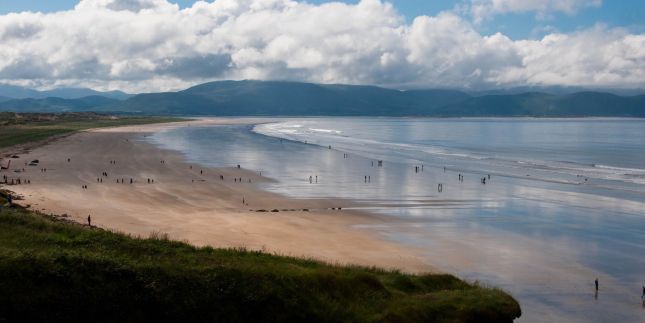
This is a very popular spot for kite surfing but many visitors will get just as much enjoyment by simply packing a camera!

Cork is served by an international airport with connections to 49 European destinations. The airport is just 8km from the city centre and is well served by local taxis and buses. Flights from non-European cities are only possible via Dublin or with a European stop-over. Taxis from the airport are available directly outside the terminal. Details for the airport-to-city bus service (journey time: 10-20 mins, bus numbers 226, 226A and 252) can be found here.
You have a number of options if you're travelling from Cork Airport to Kerry. To drive will take an hour and 30 minutes. There are a number of car rental companies located in the arrivals hall of Cork Airport. There is no direct bus from Cork Airport to Kerry but Parnell Bus Station operates a route to Tralee, the bus between Cork Airport and the city leaves every 30 minutes during the day. The same bus can also take you to Kent Railway Station in Cork City, from here you can catch a train to either Killarney or Tralee.
If you are flying to Ireland from North America your best bet is to fly into Dublin Airport and head southwest from there. Unfortunately, there is no longer a flight connecting Dublin and Cork airports. If you are renting a car, Dublin Airport has numerous car rental companies on its grounds. The journey to Cork City will take 2 hours and 50 minutes (travelling on the M7 and M8 motorways). Travelling to Killarney will take 3 hours and 40 minutes (travelling on the M7 motorway). The most popular way to travel from Dublin Airport to Cork is via the bus. The direct services of Expressway or Aircoach are a cheap and hassle-free way to travel. To travel to Kerry from Dublin Airport means travelling to Heuston Station in Dublin City (route 747) and from there taking the express service to Killarney (M7 Express Service).
The best way to travel to the southwest from Shannon Airport (in County Clare) is by bus. Bus Eireann's Route 51 travels to Cork City, via Limerick. The bus from Shannon Airport to Kerry would also require a change over in Limerick. You can rent a car at Shannon Airport and drive the relatively short distance to either Cork or Kerry (1 hour and 50 minutes to Cork City & 1 hour 57 minutes to Killarney).
There are two primary places that buses and coaches stop in Cork. The first is Parnell Place bus station. This is the main bus terminal for all of the state-run buses in and out of Cork. The other location (Patricks Quay) is just across the river via a footbridge from the main station. This is where all the private bus companies pick up an drop off passengers. Both of these are right in the city centre. Both are also an easy walk to Patrick Street – the main street of Cork and also the ideal place to catch buses for local journeys.
The main bus stations in Kerry are found in the towns of Tralee and Killarney. Both of these connect Kerry with bus routes to and from the larger towns and cities of Ireland. The bus from Dublin City to Tralee takes 3 hours and 40 minutes and Killarney takes 3 hours and 48 minutes.
Kent Station is Cork city's only railway station. It is within easy walking distance of the city centre (journey time: 10 minutes walking). You will find information about trains to and from Cork here. Top Tip: Tickets are much cheaper online so it is worth booking ahead.
The towns of Killarney and Tralee are home to Kerry's two main train stations. You can find routes in and out of these stations to and from larger towns and cities across Ireland. Both Killarney and Tralee train stations are located in their town centres.
Arriving in Cork by car is quite straightforward. The city is well serviced by motorways and there is a clear ring road around the city. The best city centre location to aim for is Parnell Place bus station. This is close enough to the edge of the city to not be stuck in traffic and also close enough to the centre to make it an easy walk. There are a number of multi-story car parks in the centre (see here). Alternatively, if you do not want to go into the city centre, there is a park-and-ride system which is available here.
Kerry also has a great road network between its main towns. Like most counties in Ireland, once you go beyond the primary and secondary roads in Kerry everything seems a lot more compact and narrow. This is especially true on the infamous roads of the Ring of Kerry.
There are direct ferry services to Cork harbour (20 minutes from the city) from France and Spain. There are also ferry services to Ireland from the UK and the Isle of Man. These arrive in places like Rosslare (3 hours from Cork) and Dublin (3.5 hours from Cork). You will find more information on Ferry routes to ireland here.

Cork is well served by a reliable bus service and you're well advised to look into bus routes before making any final decisions about student accommodation.
The most common bus routes for UCC and CIT students are the 205, 208 and 219.

The city benefits from an affordable bike hire scheme which can be a very cost-effective (and eco-friendly) way of getting to and from your places of study. Cork has a total of 32 pick-up and drop-off stations, two of which are in the vicinity of UCC.
An annual pass costs just €10. Thereafter, the first 30 minutes of each journey is free and trips lasting up to one hour cost just €0.50. Find out more...

A good taxi cab service is in operation throughout Cork and you can find the main taxi rank situated conveniently in the centre of Patrick Street. Some taxis are licensed to pick up passengers on demand (known as hackney carriages), others are for advanced bookings only.
A taxi from Patrick Street to UCC might cost in the region of €5-8 depending on traffic. The same journey to CIT's Bishopstown campus would be more like €8-12.
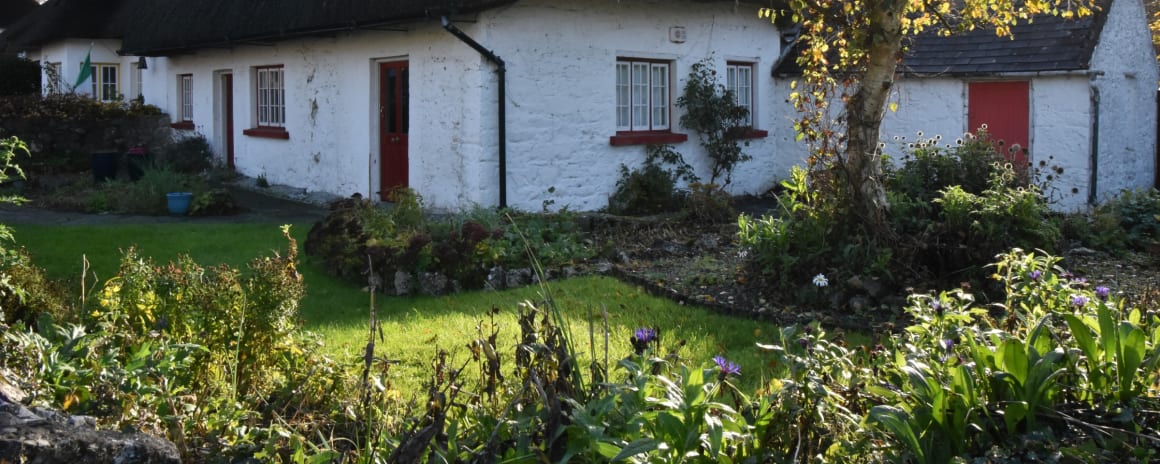
Adare is a small town in Co. Limerick, known for its quaint and colourful thatched cottages. Adare is considered to be one of Ireland's most beautiful towns so stop and take in the view. Don't forget your camera today - the perfect chance to capture the essence of old Ireland.
Explore Adare Village along the Wild Atlantic Way.
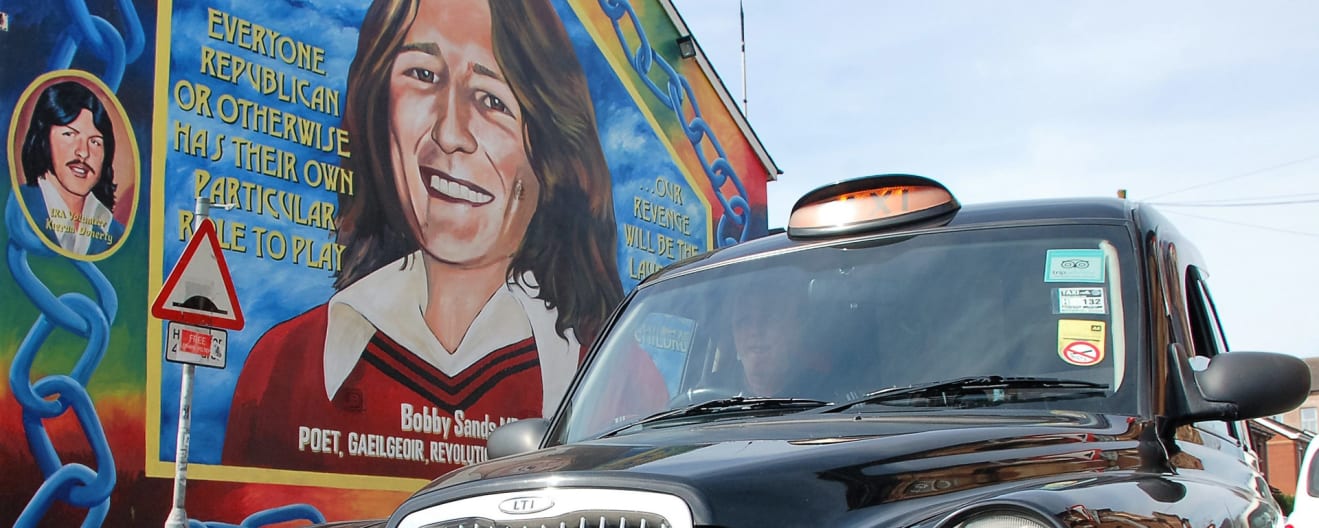
Take a journey through this once troubled city. See the murals of the Loyalist Shankill Road & Nationalist Falls Road. The Troubles took their toll on the economic life of Belfast, but the past ten years of peace have returned much prosperity while the genuine friendliness of the city never left.
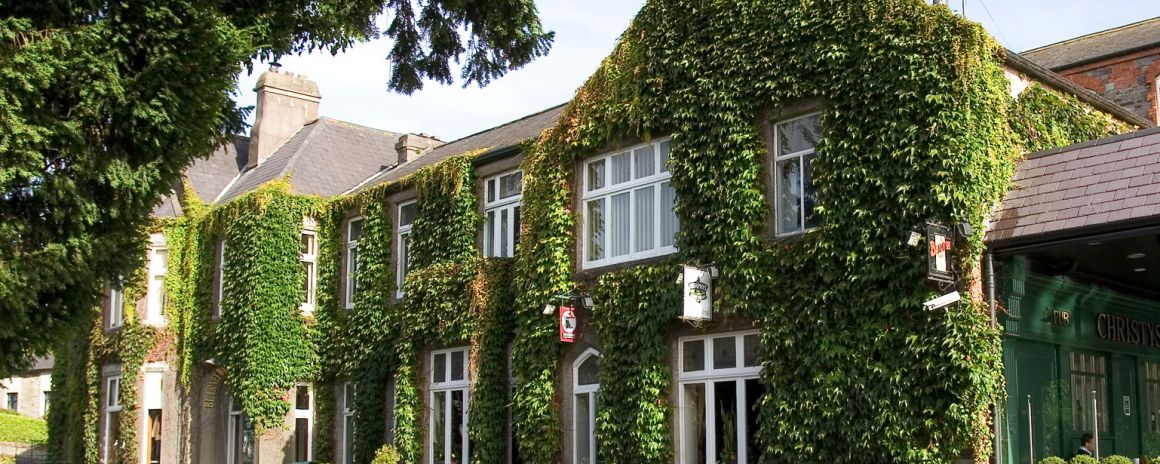
Originally built in 1823, Blarney Woollen Mills was mainly used for the spinning and weaving of wool. After it closed in 1973, it reopened in 1975 — as an Irish heritage shop.
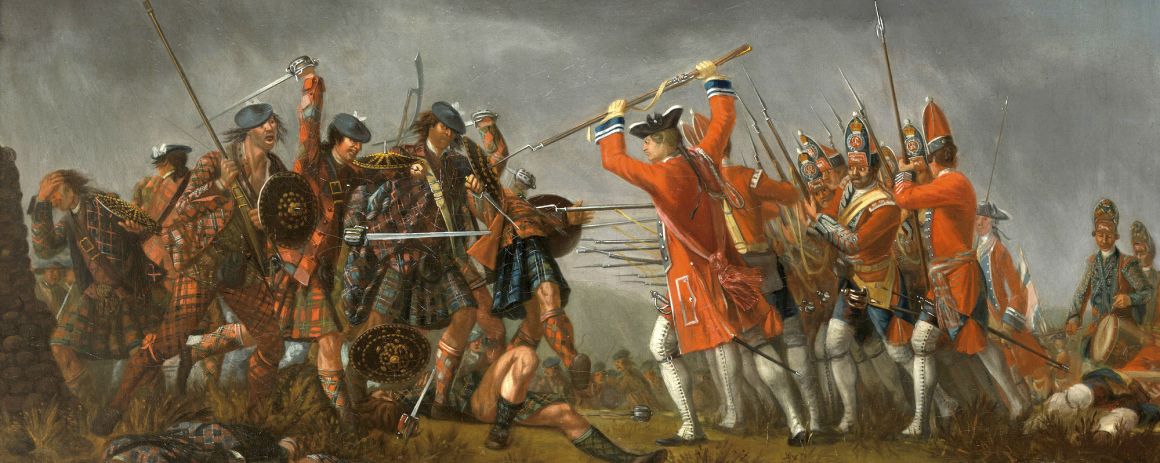
The Culloden Battlefield Visitor Centre commemorates the last pitched battle fought on British soil, in April 1746. Learn more about the Jacobite intent to overthrow the House of Hanover and return the House of Stuart to the British throne.
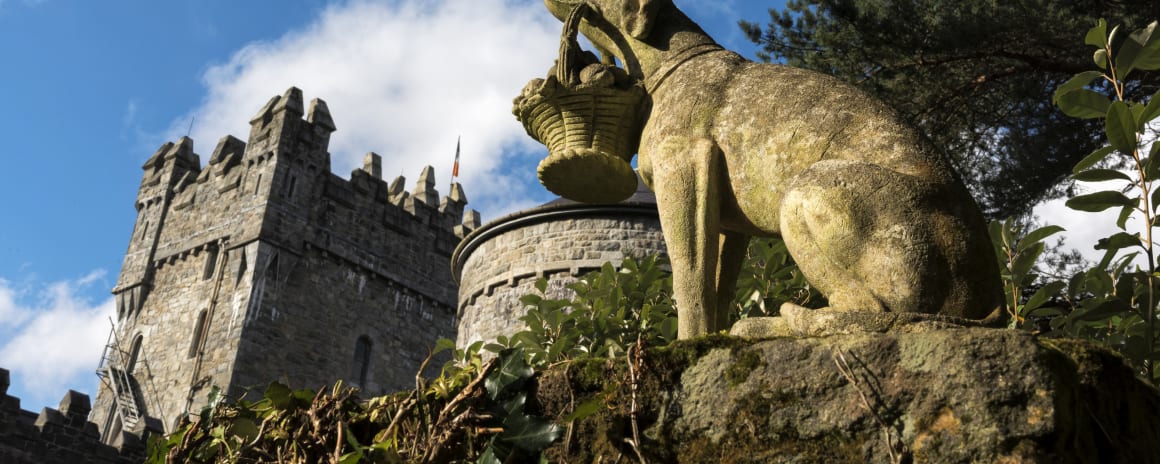
Located within Glenveagh National Park, Glenveagh Castle was built by Captain John George Adair between 1870 and 1873. Having made his fortune through land speculation in America, Adair return to Ireland and began large amounts of land in County Donegal. The castle was built in the Scottish Baronial style and is surrounded by a garden and commands stunning views of the nearby mountains, lakes, woodlands and valleys.
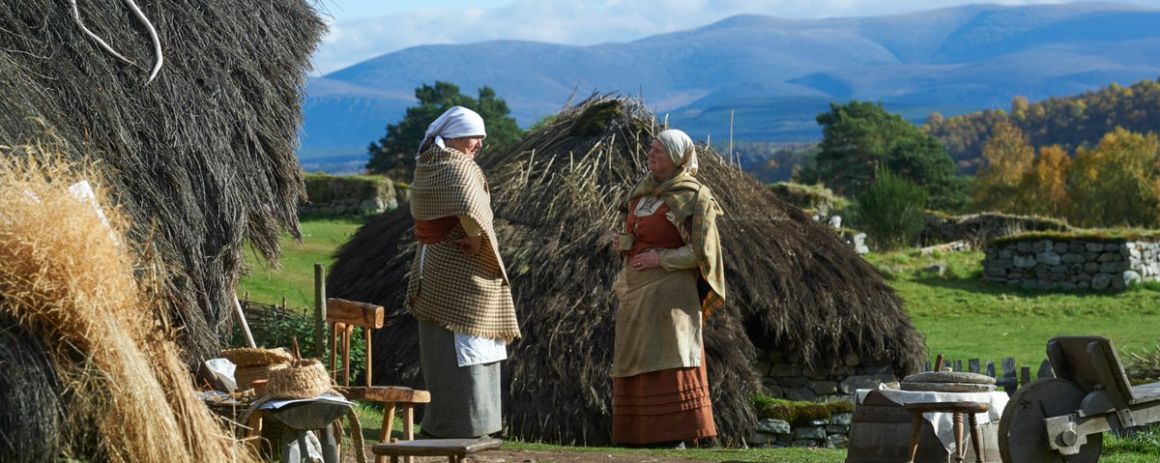
About Highland Folk Museum is a museum and open-air attraction located in the Scottish Highlands. It is designed to showcase the domestic and working lives of the early highland people.
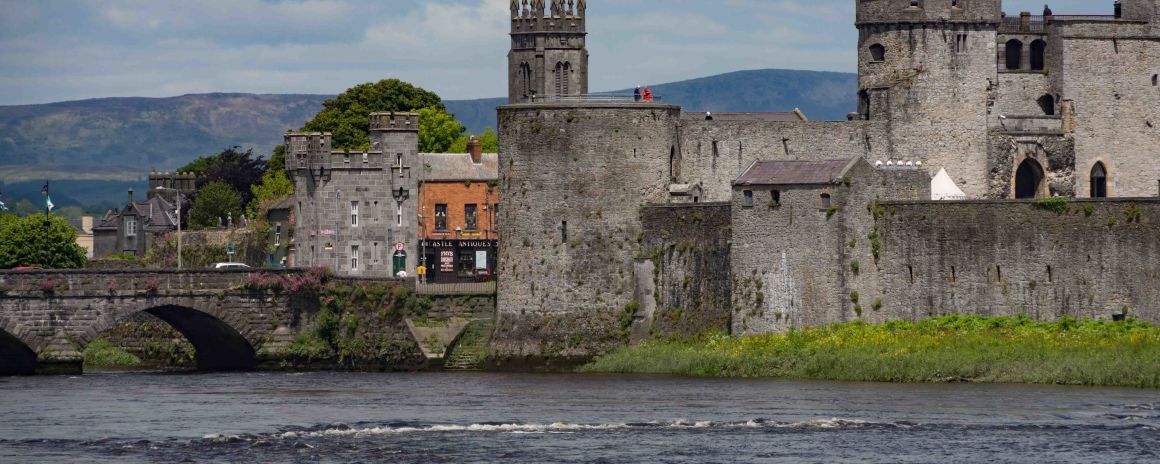
Located alongside the River Shannon in County Limerick, on King's Island. Dating back to 922, to a time when Vikings were the inhabitants of the island (Thormodr Helgason, the Viking sea-king, built the first settlement here. The castle itself was built in 1200, under the instruction of King John of England.

Located alongside the River Shannon in County Limerick, on King's Island. Dating back to 922, to a time when Vikings were the inhabitants of the island (Thormodr Helgason, the Viking sea-king, built the first settlement here. The castle itself was built in 1200, under the instruction of King John of England.
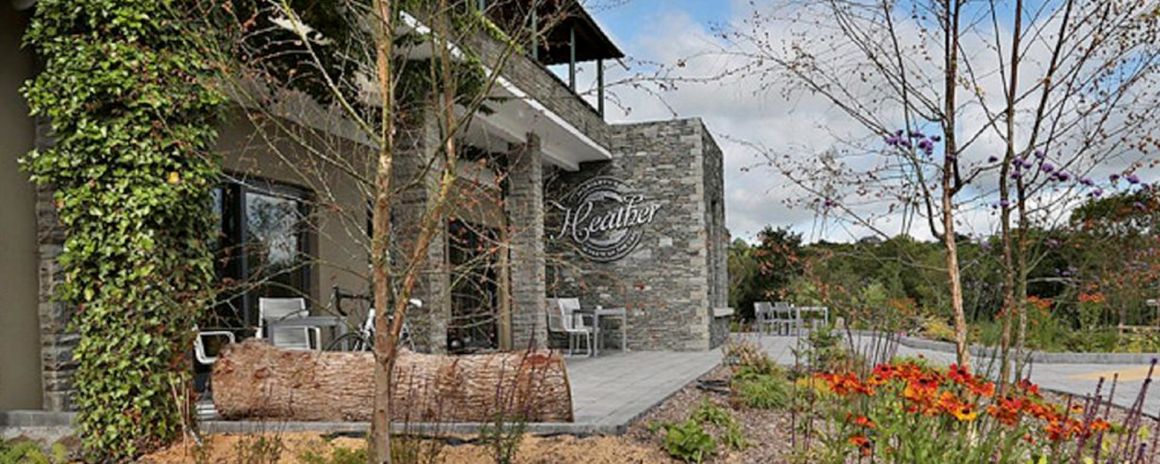
Located close to the Killarney National Park, Moriarty's is an Authentic Irish Gift Store and Restaurant. Hand crafted Irish jewellery, Waterford Crystal and classic and modern tweed fashions and furnishings are all on offer at the gift store. The restaurant is an 85 seater offering stunning views of the surrounding landscape.
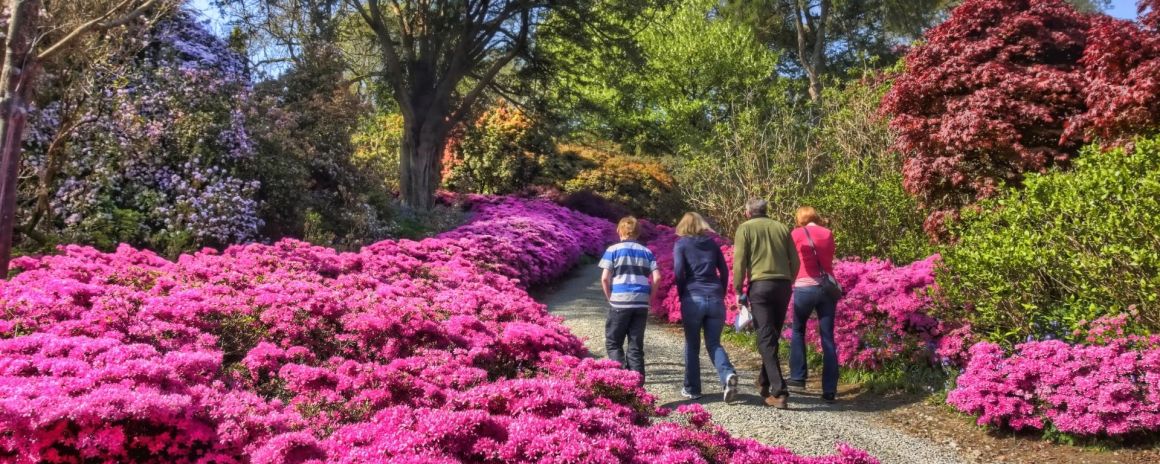
Mount Congreve Gardens. Located in Kilmeaden, County Waterford, Mount Congreve Gardens is an 18th century Georgian estate and mansion. It was designed by the same architect that created both of Waterford's cathedrals, John Roberts.
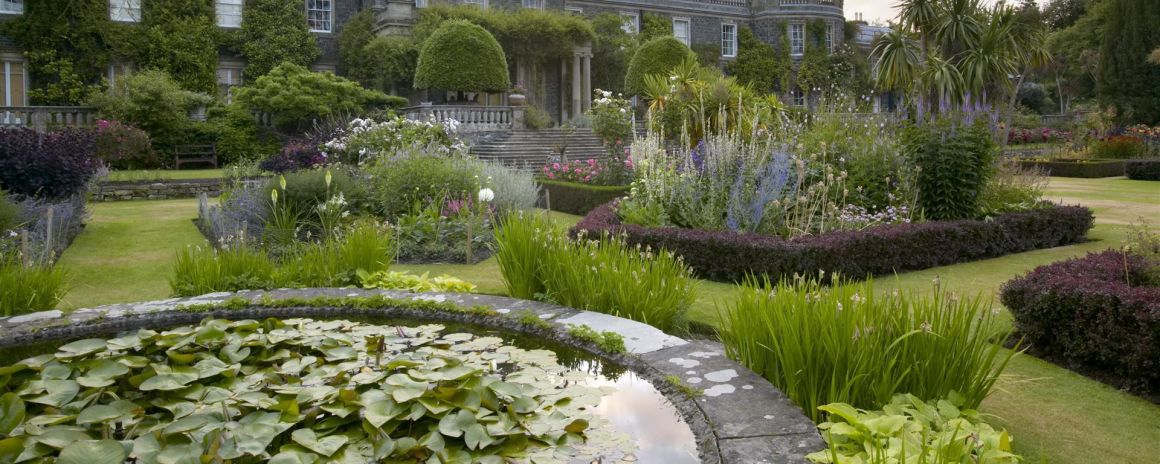
Recently recognised as being one of the top 10 gardens in the world, Mount Stewart is a rich tapestry of planting plant life and stunning walking trails. The house dates back to the 19th century, and was the Irish seat of the Vane-Tempest-Stewart family.
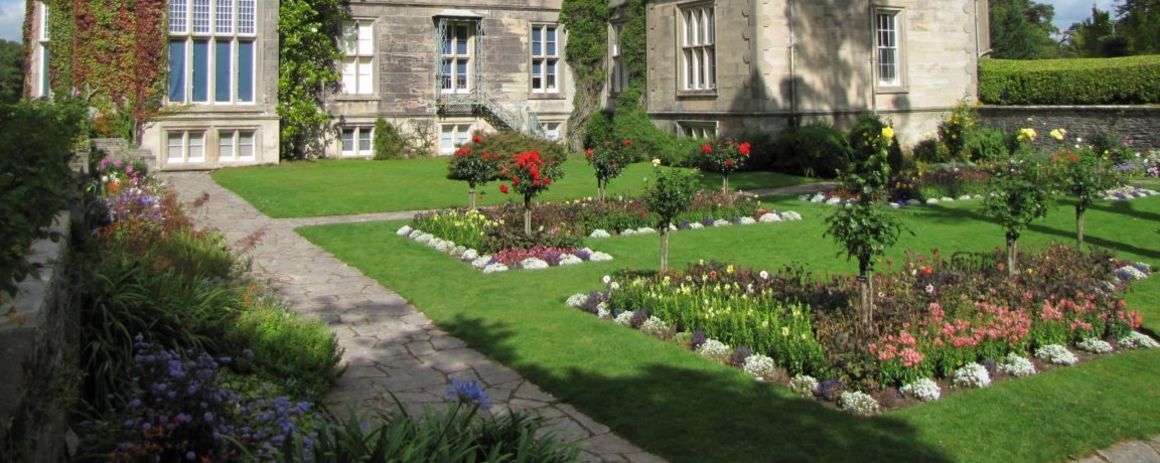
Located on the grounds of the expansive and idyllic Killarney National Park. Muckross House, and its 11,000-acre grounds, was donated to the Irish state in 1932.
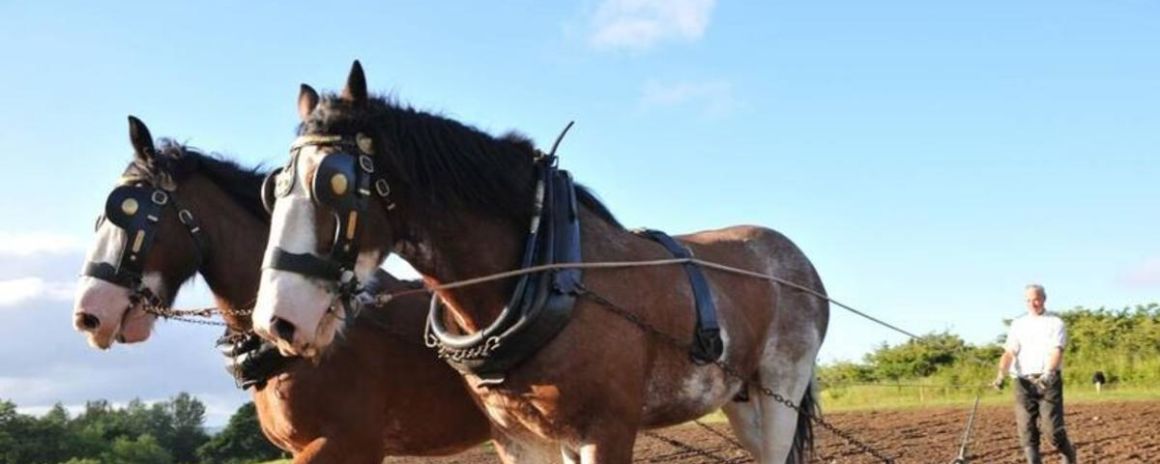
Located on the grounds of the picturesque Muckross House and its impeccable gardens. Take a step back in time and see the Irish farming lifestyle of the 1930s and '40s. A time when the horse was responsible for much of the labour and the weather was the be all and end all in terms of production.

The Quiet Man Museum. A reproduction of the quaint thatched cottage from the John Wayne starring, John Ford directed movie of the same name. all costumes, artefacts and furnishings have been recreated in precise detail, to reflect the setting of the 1952 classic. Located in the picturesque village of Cong, County Mayo.